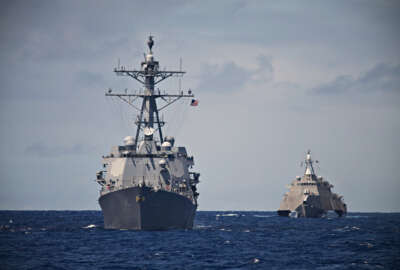Insight by Leidos
DoD Cloud Exchange: Leidos’ Eric Moore on Navy network transformation
As the Navy moves more services to the cloud it’s simultaneously working to upgrade its network operations. We talk to Leidos’ Eric Moore about how his team...
Leidos last August took on “end-to-end IT operations” for the Navy and Marine Corps Intranet (NMCI) and the OCONUS Naval Enterprise Network (ONE-Net), as well as support for the Marine Corps Enterprise Network. In 2020, Leidos won the $7.7 billion Navy Next Generation Network Recompete – Service Management, Integration and Transport contract, also known as NGEN-R SMIT.
Eric Moore, vice president and SMIT delivery manager at Leidos, said the company is looking to bring a “qualitative, analytical” approach to modernize a network that spans some 650,000 users and 1,500 locations.
“We go out to all the stakeholders with the Navy and seek their input on what they value — not what they want, but what they value,” Moore said during Federal News Network’s second annual DoD Cloud Exchange. “And then we take that value dimension that they’ve offered to us, and we take all of the possible transformative initiatives, we actually run it through an algorithm and determine which of those candidate initiatives will deliver the best value to the broadest range of stakeholders that the enterprise is meant to support.”
The approach removes any human bias and focuses on what services will provide the best value, he said. The process helps inform annual planning, with the process getting “recycled” every six months, Moore said.
“So it’s not static. It’s very agile as priorities change. As things in the world cause value equations to differ, we can change the transformation roadmap for the Navy,” he said.
Helping Navy move to the cloud
One of the big focuses has been helping the service move mission and enterprise workloads to cloud environments, Moore said. That includes the Navy’s shift to a single Microsoft Office 365 collaboration and productivity environment.
The move to cloud platforms allows for faster technology updates and upgrades and also makes it easier for the Navy to deploy enterprise tools to more remote environments, Moore said.
“So you start to think about how do we get these enterprise capabilities closer to the tactical edge? So that when we’ve got decisions that need to be made in a remote or [denied, degraded, intermittent and latent] environment, we have the ability to provide those capabilities and resources that the enterprise provides in those situations,” Moore said. “We really want to be able to see how can we push the power and value of the enterprise as close to the fight, as close to the edge, as possible?”
An emphasis under the contract is improving the performance of Navy and Marine Corps networks, so they can take full advantage of cloud services. A major data point, Moore said, is how many network hops it takes for users to access various computing services.
“It’s really about changing the core architecture of the Navy’s network, so that the access points into that broader cloud infrastructure are co-located in the right place and with the right technology stack to allow traffic to flow,” Moore said. “How do we change the number of network hops that it takes, either when we move the application or when we flatten the network, and make it more efficient for users across the country and across the world who are using this network to get to those services?”
To listen to and watch all the sessions from the 2022 Federal News Network DoD Cloud Exchange, go to the event page.
Copyright © 2024 Federal News Network. All rights reserved. This website is not intended for users located within the European Economic Area.
Related Stories
Featured speakers
-

Eric Moore
Vice President and Director, Digital Modernization, Leidos
-

Justin Doubleday
Reporter, Federal News Network
On DoD
Upcoming Events
Related Stories
Top Stories

Eric Moore
Vice President and Director, Digital Modernization, Leidos
Eric Moore is vice president and delivery program manager for the Leidos team supporting the U.S. Department of the Navy’s Next Generation Enterprise Network (NGEN) Service Management, Integration and Transport (SMIT) contract. The NGEN SMIT contract provides for the end-to-end IT operations of the Navy Marine Corps Intranet (NMCI), the OCONUS Naval Enterprise Network (ONE-Net), and the Marine Corps Enterprise Network (MCEN). Combined, the three networks provide critical connectivity to more than 650,000 uniformed and civilian professionals at more than1,500 locations across the United States and worldwide.
Prior to his current role, Eric served as the chief of staff to the Leidos Chairman and CEO, Roger Krone. Additionally, throughout his more than 15 years with Leidos, Eric has held numerous positions supporting key customers in the intelligence, law enforcement, healthcare, finance and homeland security communities. Eric brings a track record of successful modernization projects in support of critical national security and infrastructure systems and has experience in leading IT operations for large and geographically diverse organizations.
Eric holds bachelor’s degrees in electrical engineering and computer engineering from the University of Michigan, a Master of Science in computer science from Johns Hopkins University and a Master of Science in technology management from the University of Pennsylvania. Additionally, Eric holds active Project Management Professional and Certified Information Systems Security Professional certifications.

Justin Doubleday
Reporter, Federal News Network
Justin Doubleday is a defense and cybersecurity reporter for Federal News Network. He previously covered the Pentagon for Inside Defense, where he reported on emerging technologies, cyber and supply chain security. Justin is a 2013 graduate of the University of New Hampshire, where he received his B.A. in English/Journalism.







